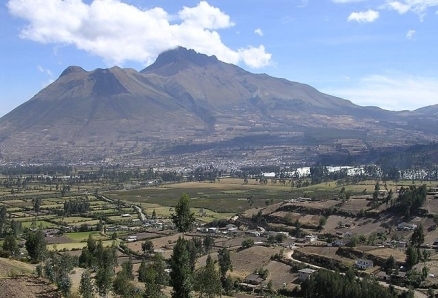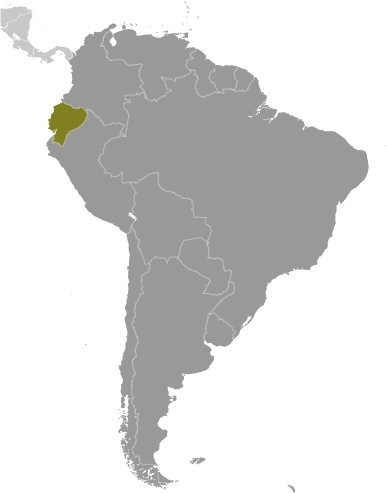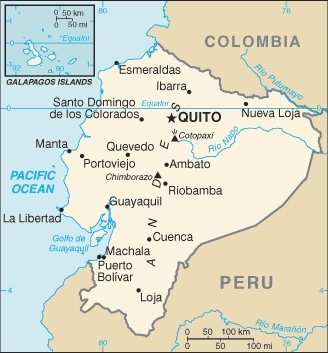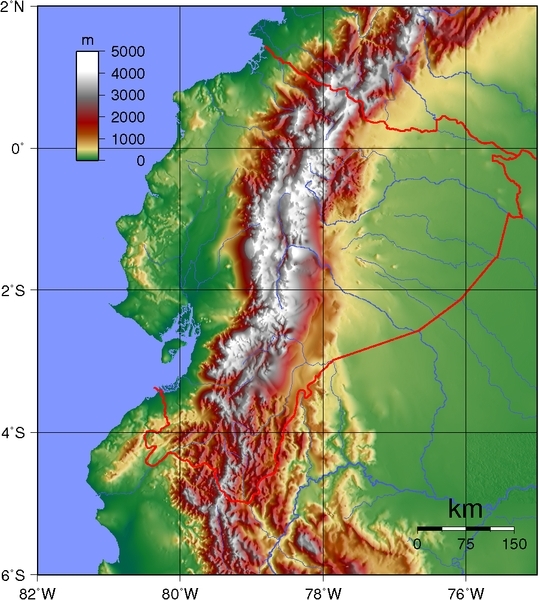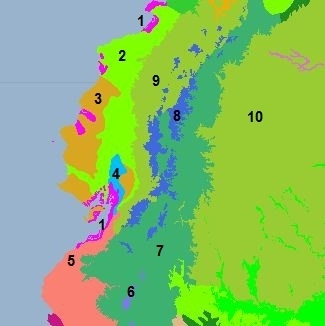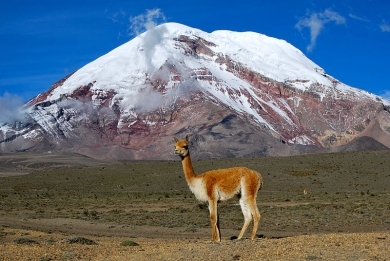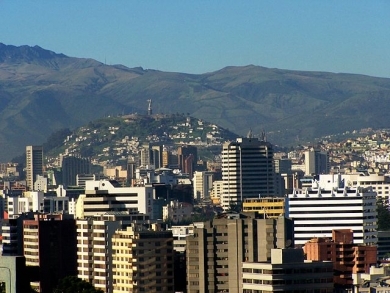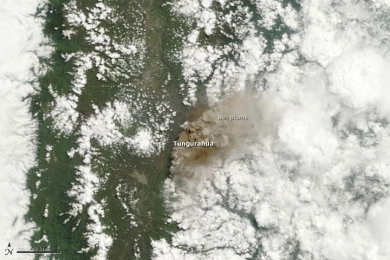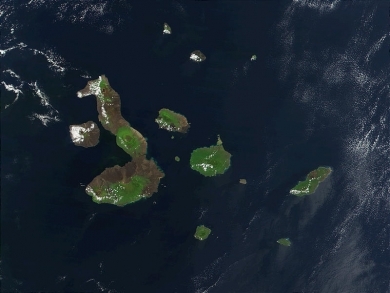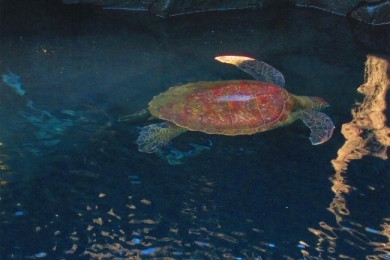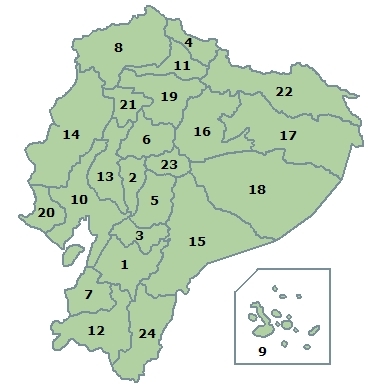Ecuadorian
Contents
Ecuador
Countries and Regions of the World Collection  Ecuador is a nation of fifteen million people in South America bordering the Pacific Ocean at the equator between Columbia and Peru. The equator, which gives the country its name (which means "Republic of the Equator"), passes through Ecuador just north of the capitol city, Quito.
Ecuador is a nation of fifteen million people in South America bordering the Pacific Ocean at the equator between Columbia and Peru. The equator, which gives the country its name (which means "Republic of the Equator"), passes through Ecuador just north of the capitol city, Quito.
The biodiversity-rich and environmentally-sensitive Galápagos Islands are part of the country and lie 972km (604 miles) east of the mainland in the Pacific Ocean.
Its major environmental issues include:
- deforestation (Deforestation in Amazonia);
- soil erosion;
- desertification;
- water pollution; and, pollution from oil production wastes in ecologically sensitive areas of the Amazon Basin and Galapagos Islands.
Ecuador is susceptible to Frequent earthquakes, landslides, volcanic activity, floods, and periodic droughts.
Cotopaxi in the Andes is highest active volcano in world.
Due to the fact that the earth is not a perfect sphere and has an equatorial bulge, the highest point on the planet furthest from its center is Mount Chimborazo not Mount Everest, which is merely the highest peak above sea-level.
What is now Ecuador formed part of the northern Inca Empire until the Spanish conquest in 1533.
Quito became a seat of Spanish colonial government in 1563 and part of the Viceroyalty of New Granada in 1717.
The territories of the Viceroyalty - New Granada (Colombia), Venezuela, and Quito - gained their independence between 1819 and 1822 and formed a federation known as Gran Colombia.
When Quito withdrew in 1830, the traditional name was changed in favor of the "Republic of the Equator."
Between 1904 and 1942, Ecuador lost territories in a series of conflicts with its neighbors.
A border war with Peru that flared in 1995 was resolved in 1999.
Although Ecuador marked 25 years of civilian governance in 2004, the period has been marred by political instability. Protests in Quito have contributed to the mid-term ouster of Ecuador's last three democratically elected Presidents.
In September 2008, voters approved a new constitution; Ecuador's twentieth since gaining independence.
General elections, under the new constitutional framework, were held in April 2009, and voters re-elected President Rafael Cprrea.
Geography
Geographic Coordinates: 2 00 S, 77 30 W
Area: 283,560 km2 (276,840 km2 land and 6,720 km2 water). This includes the Galapagos Islands.
Land Boundaries: 2,010 km. Border countries are Colombia 590 km and Peru 1,420 km
Coastline: 2,237 km
Maritime Claims:
territorial sea: 200 nm
continental shelf: 100 nm from 2,500-m isobath
Natural Hazards: Frequent earthquakes, landslides, volcanic activity; floods; periodic droughts
volcanism: Ecuador experiences volcanic activity in the Andes Mountains; Sangay (elev. 5,230 m), which erupted in 2010, is mainland Ecuador's most active volcano; other historically active volcanoes in the Andes include Antisana, Cayambe, Chacana, Cotopaxi, Guagua Pichincha, Reventador, Sumaco, and Tungurahua; Fernandina (elev. 1,476 m), a shield volcano that last erupted in 2009, is the most active of the many Galapagos volcanoes; other historically active Galapagos volcanoes include Wolf, Sierra Negra, Cerro Azul, Pinta, Marchena, and Santiago
Terrain: Coastal plain (costa), inter-Andean central highlands (sierra), and flat to rolling eastern jungle (oriente) . The highest point is Chimborazo (6,267 m). Note: due to the fact that the earth is not a perfect sphere and has an equatorial bulge, the highest point on the planet furthest from its center is Mount Chimborazo not Mount Everest, which is merely the highest peak above sea-level.
Climate: Tropical along coast, becoming cooler inland at higher elevations; tropical in Amazonian jungle lowlands
Topography of Ecudor. Source: Wikimedia Commons.
Ecology and Biodiversity
|
The richest and most diverse region on Earth, the Tropical Andes passes through central Ecuador. Along the coast lies the Tumbes-Chocó-Magdalena biodiversity hotspot, which includes a wide variety of habitats and South America's only remaining coastal dry forests. There are a number of diverse terrestrial ecoregions throughout Ecuador:
Also: Galápagos Islands xeric scrub |
Protected areas
See main article: Protected areas of Ecuador
Ecuador is home to two major protected areas. The Galápagos National Park & Galápagos Marine Resources Reserve consists of the largest, most diverse almost pristine archipelago remaining in the world. It is made up of volcanic islands and the surrounding seas located west of Ecuador at the confluence of several ocean currents. The largest area of unaltered wild land in the country's eastern Cordilleras is known as Sangay National Park. It includes a wide range of ecosystems, from the tropical rainforests of the Amazon basin to mountain glaciers.
International Environmental Agreements
Ecuador is party to international agreements on: Antarctic-Environmental Protocol, Antarctic Treaty, Biodiversity, Climate Change, Climate Change-Kyoto Protocol, Desertification, Endangered Species, Hazardous Wastes, Ozone Layer Protection, Ship Pollution, Tropical Timber 83, Tropical Timber 94, and Wetlands.
People and Society
Population: 15,223,680 (July 2012 est.)
Ethnic groups: mestizo (mixed Amerindian and white) 65%, Amerindian 25%, Spanish and others 7%, black 3%
Ecuador's population is ethnically mixed. A large majority of the population is mestizo (mixed Amerindian-Caucasian), followed by smaller percentages of indigenous, Afro-Ecuadorian, and European-descendent criollos.
Although Ecuadorians were heavily concentrated in the mountainous central highland region a few decades ago, today's population is divided about equally between that area and the coastal lowlands. Migration toward cities--particularly larger cities--in all regions has increased the urban population to over 60% of the total.
The tropical forest region (or Amazon region) to the east of the mountains remains sparsely populated and contains only about 3% of the population.
Due to an economic crisis in the late 1990s, more than 600,000 Ecuadorians emigrated to the U.S. and Europe from 2000 to 2001. According to a survey by the U.S. Census bureau, there were 436,000 Ecuadorians in the United States in 2005.
| Vicuña, one of two wild South American camelids. In the background the highest placed volcano on Earth, the Chimborazo vulcano - Ecuador. Source: Wikimedia |
| Quito. Source: Patricio Mena Vásconez/Wikimedia Commons. |
|
In mid-April 2011, after a decade of low activity, Ecuador’s Tungurahua Volcano began a substantial eruption. On April 21st fine ash fell on nearby communities, followed by the appearance of small lava fountains at Tungurahua’s summit. On April 26th significant eruption of ash began, up to an altitude of 38,000 feet (12,000 meters). These emissions continued until at least May 4, 2011. Source: NASA |
|
This true-color image of the Galapagos Islands was acquired on March 12, 2002, by the Moderate-resolution Imaging Spectroradiometer (MODIS), flying aboard NASA's Terra satellite. The Galapagos Islands, which are part of Ecuador, sit in the Pacific Ocean about 1000 km (620 miles) west of South America. As the three craters on the largest island (Isabela Island) suggest, the archipelago was created by volcanic eruptions, which took place millions of years ago. Unlike most remote islands in the Pacific, the Galapagos have gone relatively untouched by humans over the past few millennia. As a result, many unique species have continued to thrive on the islands. Over 95 percent of the islands’ reptile species and nearly three quarters of its land bird species cannot be found anywhere else in the world. Two of the more well known are the Galapagos giant tortoise and marine iguanas. The unhindered evolutionary development of the islands’ species inspired Charles Darwin to begin The Origin of Species eight years after his visit there. To preserve the unique wildlife on the islands, the Ecuadorian government made the entire archipelago a national park in 1959. Each year roughly 60,000 tourists visit these islands to experience what Darwin did over a century and a half ago. Source: NASA. Credit: Jacques Descloitres, MODIS Land Rapid Response Team, NASA/GSFC |
| A sea turtle at Tagus Cove on Isabela Island (Galapagos Islands) |
Age Structure:
0-14 years: 30.1% (male 2,301,840/female 2,209,971)
15-64 years: 63.5% (male 4,699,548/female 4,831,521)
65 years and over: 6.4% (male 463,481/female 500,982) (2011 est.)
Population Growth Rate: 1.419% (2012 est.)
Birthrate: 19.6 births/1,000 population (2012 est.)
Death Rate: 5.01 deaths/1,000 population (July 2012 est.)
Net Migration Rate: -0.39 migrant(s)/1,000 population (2012 est.)
Life Expectancy at Birth: 75.94 years
male: 73 years
female: 79.04 years (2012 est.)
Total Fertility Rate: 2.38 children born/woman (2012 est.)
Languages: Spanish (official), Amerindian languages (especially Quechua)
Literacy: 91% (2001 census)
Urbanization: 67% of total population (2010) growing at an annual rate of change of 2% (2010-15 est.)
History
The Inca Empire and Spanish Conquest
Advanced indigenous cultures flourished in Ecuador long before the area was conquered by the Inca Empire in the 15th century. In 1534, the Spanish arrived and defeated the Inca armies, and Spanish colonists became the new elite. The indigenous population was decimated by disease in the first decades of Spanish rule--a time when the natives also were forced into the "encomienda" labor system for Spanish landlords. In 1563, Quito became the seat of a royal "audiencia" (administrative district) of Spain.
Independence and Historical Developments
After independence forces defeated the royalist army in 1822, Ecuador joined Simon Bolivar's Republic of Gran Colombia, only to become a separate republic in 1830. The 19th century was marked by instability, with a rapid succession of rulers. The conservative Gabriel Garcia Moreno unified the country in the 1860s with the support of the Catholic Church. In the late 1800s, world demand for cocoa tied the economy to commodity exports and led to migrations from the highlands to the agricultural frontier on the coast.
A coastal-based liberal revolution in 1895 under President Eloy Alfaro reduced the power of the clergy and opened the way for capitalist development. The end of the cocoa boom produced renewed political instability and a military coup in 1925. The 1930s and 1940s were marked by populist politicians, such as five-time President Jose Velasco Ibarra. In January 1942, Ecuador signed the Rio Protocol to end a brief war with Peru the year before. Ecuador agreed to a border that conceded to Peru much of the territory Ecuador had previously claimed in the Amazon region. After World War II, a recovery in the market for agricultural commodities and the growth of the banana industry helped restore prosperity and political peace. From 1948-60, three presidents--beginning with Galo Plaza--were freely elected and completed their terms. Political turbulence returned in the 1960s, followed by a period of military dictatorship between 1972 and 1979. The 1980s and beginning of the 1990s saw a return to democracy, but instability returned by the middle of the decade.
Political Instability (1997-2006)
Abdala Bucaram, from the Guayaquil-based Ecuadorian Roldosista Party (PRE), won the presidency in 1996 on a platform that promised populist economic and social policies, and challenged what Bucaram termed as the power of the nation's oligarchy. During his short term of office, Bucaram's administration was severely criticized for corruption. Bucaram was deposed by the Congress in February 1997 on grounds of alleged mental incompetence. In his place, Congress named Fabian Alarcon interim president. Alarcon's presidency was endorsed by a May 1997 popular referendum.
Quito mayor Jamil Mahuad of the Popular Democracy party was elected president by a narrow margin in July 1998. Mahuad concluded a historic peace agreement with Peru on October 26, 1998, but increasing economic, fiscal, and financial difficulties drove his popularity steadily lower. On January 21, 2000, during demonstrations in Quito by indigenous groups, the military and police refused to enforce public order. Demonstrators entered the congressional building and declared a three-person "junta" in charge of the country. Field-grade military officers declared their support for the concept. During a night of confusion and negotiations, President Mahuad fled the presidential palace. Vice President Gustavo Noboa took charge and Mahuad went on national television to endorse Noboa as his successor. Congress met in emergency session in Guayaquil the same day, January 22, and ratified Noboa as President of the Republic.
Completing Mahuad's term, Noboa restored some stability to Ecuador. He implemented the dollarization of the economy that Mahuad had announced and obtained congressional authorization for the construction of Ecuador's second major oil pipeline, this one financed by a private consortium. Noboa turned over the government on January 15, 2003, to his successor, Lucio Gutierrez, a former army colonel who first came to public attention as a member of the short-lived "junta" of January 21, 2000. Gutierrez' campaign featured an anti-corruption and leftist, populist platform. After taking office, however, Gutierrez adopted relatively conservative fiscal policies and defensive tactics, including replacing the Supreme Court and declaring a state of emergency in the capital to combat mounting opposition. The situation came to a head on April 20, 2005, when political opponents and popular uprisings in Quito prompted Congress to strip Gutierrez of the presidency for allegedly "abandoning his post." When the military withdrew its support, Gutierrez went into temporary exile. Congress declared Vice President Alfredo Palacio the new president. A semblance of stability returned, but the Palacio administration failed to achieve congressional support for major reforms.
The Correa Administration (2007-present)
In October 2006 presidential elections, third-time candidate Alvaro Noboa won the first round. Rafael Correa bested Noboa in the second-round presidential runoff in November 2006. Correa was Palacio's former finance minister; he ran on an anti-establishment reform platform and successfully presented himself as the "change" candidate. Election observers characterized the elections as generally free, fair, and transparent. Noboa's National Institutional Renovation and Action Party won the largest bloc in Congress in 2006 elections, followed by Gutierrez's Patriotic Society Party; Correa's Proud and Sovereign Fatherland (PAIS) movement did not field any congressional candidates. Traditional parties saw their congressional representation cut in half.
The new Congress took office on January 5, 2007, and Correa was sworn in as President on January 15, 2007. In March 2007, the Supreme Electoral Tribunal dismissed 57 members of Congress on the grounds that they violated campaign laws. Following that, the Congress was largely deadlocked and later effectively replaced by a constituent assembly that was voted into power on September 30, 2007. The assembly, which was inaugurated on November 29, 2007, drafted a new constitution that voters approved in a referendum and that went into effect in October 2008. The new constitution was Ecuador's 20th since independence.
As required under the new constitution, elections for the president, vice president, members of the National Assembly, and provincial and local offices were held in April 2009, 2 years into Correa's first term. President Correa was re-elected in the first round, taking 52% of the vote, compared to 28% for former president Lucio Gutierrez, his nearest rival. Correa's PAIS movement also won the largest legislative bloc in the new National Assembly, although not a majority.
Correa has asserted that his political project, which he calls the "Citizens' Revolution," intends to search for social justice and reassert the supremacy of human labor over capital. His government has increased spending on housing, health care, and other popular social programs.
Ecuador had been caught in cycles of political instability, reflecting popular disillusionment with traditional power structures and weak institutions. Ecuador's political parties have historically been small, loose organizations that depend more on populist, often charismatic, leaders to retain support than on programs or ideology. Frequent internal splits produced great factionalism. Beginning with the 1996 election, the indigenous population abandoned its traditional policy of shunning the official political system and participated actively. The indigenous population established itself as a force in Ecuadorian politics, and participated in the Gutierrez administration before joining the opposition.
Correa is the longest-serving president since the 1979 return to democracy, and is the first since then to enjoy sustained popularity in all regions of the country and among a broad array of class and demographic groups. President Correa has criticized the traditional political parties. Opposition parties are generally weak and are seeking ways to revive themselves. As of February 2011, President Correa's PAIS movement was the predominant political force in Ecuador, though PAIS did not hold an outright majority of seats in the National Assembly.
Foreign Relations
Ecuador always has placed great emphasis on multilateral approaches to international problems. Ecuador is a member of the United Nations (and most of its specialized agencies), the Organization of American States, and many regional groups, including the Rio Group, the Latin American Energy Organization, the Union of South American Nations (UNASUR), and the Community of Andean Nations. From August 2009 to November 2010, Ecuador held the rotational presidency of UNASUR. Ecuador is also a member of the Community of Latin American and Caribbean States (CELAC), which was inaugurated in Caracas in December 2011.
Under the Correa administration, Ecuador has increased its efforts to strengthen and diversify its political and economic ties with countries in Latin America, Europe, and Asia. In Latin America, President Correa has traveled to Peru, Chile, Brazil, Argentina, Venezuela, Costa Rica, Panama, Uruguay, Haiti, and Cuba, for example, where his government has signed agreements to promote economic cooperation. Similarly, outside the region, Correa has visited Spain, Italy, France, China, Iran, and Russia, among other countries.
In October 1998, Ecuador and Peru reached a peace agreement to settle their border differences, which had festered since the signing of the 1942 Rio Protocol. This long-running border dispute occasionally erupted into armed hostility along the undemarcated sections, with the last conflict occurring in 1995. The U.S. Government, as one of the four guarantor nations (the others were Argentina, Brazil, and Chile), played an important role in bringing the conflict to an end. The peace agreement brokered by the four guarantors in February 1995 led to the cessation of hostilities and a Military Observers Mission to Ecuador-Peru (MOMEP), which monitored the zone. In addition to helping broker the peace accord, the U.S. has been active in demining the former area of conflict and supporting welfare and economic projects in the border area.
The ongoing conflict in Colombia and security along the 450-mile-long northern border are important issues in Ecuador's foreign relations with Colombia. The instability of border areas and frequent encroachments of Colombian guerillas into Ecuadorian territory has led the Ecuadorian army to deploy more troops to the region. Although Ecuadorian officials have stated that Colombian guerrilla activity will not be tolerated on the Ecuadorian side of the border, guerrilla bands have been known to intimidate the local population, demanding extortion payments and practicing vigilante justice. The Correa administration is pursuing a policy known as Plan Ecuador to develop the northern border region and protect citizens from the drug threat. A Colombian military incursion into Ecuador in March 2008 caused the Government of Ecuador to break diplomatic relations. In November 2010, Ecuador and Colombia fully re-established diplomatic relations.
Government
The 2008 constitution provides for 4-year terms of office for the president, vice president, and members of the National Assembly. Presidents may be consecutively re-elected for an additional term. The executive branch currently includes 38 core cabinet members, (including coordinating ministries with inter-governmental responsibility and national secretariats). Provincial leaders (called prefects) and councilors, mayors, city councilors, and rural parish boards are directly elected. The National Assembly elected in April 2009 replaced the interim Legislative Commission on July 31, 2009. The National Assembly is unicameral with 124 legislators. The seven members of the Citizen Participation Council, under the transparency and social participation branch of government, were sworn in on March 18, 2010, for a 5-year term. The electoral branch of government is headed by the National Electoral Council, whose president was selected on November 29, 2011 to serve a 6-year term. According to the constitution, justices of the National Court of Justice are to be selected by a Judicial Council through a merit-based process for a 9-year term, with no immediate reappointment. A special committee, composed of members selected by all branches of government, are to appoint the members of the Constitutional Court to serve a 9-year term, with no reappointment. However, a referendum held in May 2011 gave a “transitional council” exceptional powers to reform the judicial sector and appoint its key personnel within 18 months.
Government Type: Republic
Capital: Quito -1.801 million (2009)
Other Major Cities: Guayaquil - 2.634 million (2009)
|
Administrative divisions: 24 provinces (provincias, singular - provincia);
|
Source: Wikimedia Commons |
Independence Date: 24 May 1822 (from Spain)
Legal System: civil law based on the Chilean civil code with modifications. Ecuadopr has not submitted an International Court of Justice (ICJ) jurisdiction declaration. It accepts International criminal court (ICCt) jurisdiction
Water
Total Renewable Water Resources: 432 cu km (2000)
Freshwater Withdrawal: 16.98 cu km/yr (12% domestic, 5% industrial, 82% agricultural)
Per Capita Freshwater Withdrawal: 1,283 cu m/yr (2000)
Agriculture
Agricultural products:
Irrigated Land: 8,650 sq km (2008)
Resources
Natural Resources: petroleum, fish, timber, hydropower
Land Use:
arable land: 5.71%
permanent crops: 4.81%
other: 89.48% (2005)
Energy
The oil sector dominates the Ecuadorian economy, accounting for 40 percent of export earnings and one-third of all tax revenues. According to Oil and Gas Journal, Ecuador held proven oil reserves of 4.6 billion barrels, the third largest in South America, and 345 billion cubic feet (Bcf) of natural gas reserves as of January 2006. There is negligible domestic demand or support infrastructure for natural gas. Ecuador produced 14.84 billion kilowatt-hours (Bkwh) of electricity and consumed 12.9 Bkwh in 2006. About 63 percent of Ecuador's electricity production comes from hydroelectricity, with the balance supplied by conventional thermal plants.
See Energy profile of Ecuador.
Conflict
International Disputes: organized illegal narcotics operations in Colombia penetrate across Ecuador's shared border, which thousands of Colombians also cross to escape the violence in their home country
Economy
The Ecuadorian economy is based on petroleum production, manufacturing primarily for the domestic market, commerce, and agricultural production for domestic consumption and export. Principal exports are petroleum, bananas, shrimp, flowers, and other primary agricultural products. In 2010, crude and refined petroleum products accounted for 56% of total export earnings. Ecuador is the world's largest exporter of bananas and plantains (about $2 billion) and a major exporter of shrimp ($828 million) and cacao ($402 million). Exports of nontraditional products such as flowers ($598 million), canned fish ($601 million), and automobiles ($375 million) have become more important in recent years.
The oil sector typically accounts for 50%-60% of the country’s export earnings, 15%-20% of GDP, and 30%-40% of government revenues. Oil production is primarily carried out by the government, as well as by small domestic and several large foreign companies. Oil production declined between 2006 and 2009 due to insufficient investment, before leveling out in 2010 and increasing only slightly in 2011. In late 2010 and early 2011, the government renegotiated all oil concession contracts, moving from a production-sharing arrangement to service (fee) contracts. Several oil companies declined to renegotiate; those operations were devolved to the state oil company, increasing the state’s share of national oil production from 62% in 2010 to roughly 72% in 2011. Despite oil contract renegotiations, public and private investments in the sector have remained relatively flat. Additional oil concessions for new large tracts in the southern part of the country are expected to be offered in early 2012.
The mineral sector has been developing slowly. In early 2011, government negotiations commenced with major mining companies interested in moving from an exploratory phase into production and were ongoing as of January 2012. To foster diversification of Ecuador’s economy, the Ecuadorian Government enacted a Production, Trade, and Investment Code in late 2010. The code is intended to promote production of higher value-added products, in particular by small and medium-sized businesses located in regions outside the major business centers of Quito and Guayaquil.
Ecuador adopted the dollar as its national currency in 2000, following a major banking crisis and recession in 1999. Dollarization led to stability, which helped Ecuador achieve solid economic performance through 2006. In 2007, economic growth slowed, constrained by declining petroleum production and reduced private sector investment, before recovering in 2008 with high oil prices. However, by the end of 2008, the global financial crisis and economic downturn led to falling remittances and declining oil revenue for Ecuador. In December 2008 the government defaulted on certain debt issuances (its 2012 and 2030 Global bonds, with a total face value of approximately U.S. $3.2 billion). In June 2009, the government repurchased 91% of these bonds at a 65%-70% discount in a modified Dutch auction. Although oil prices rebounded in 2009, economic growth slowed due to a fall in internal demand. Remittances from foreign workers, Ecuador’s second-largest source of external revenues, after petroleum, declined 12% due to the worsening economic conditions in the United States and Spain, the two most important origins for remittances. According to official statistics, the real annual growth rate for Ecuador’s economy in 2009 was 0.36%.
As the global economy began to recover in 2010, Ecuador’s economy rebounded with a 3.6% growth rate. However, limited access to international financing, following the 2008 sovereign default, forced the government to reduce expenditure levels and cover a budgetary financing gap with loans from international financial institutions, funds from Ecuador’s Social Security Institute, and financing from China. Ecuador has negotiated financing worth almost $7 billion from China since 2009, often with interest rates above those generally charged by international financial institutions, such as the World Bank. Remittances from workers abroad have yet to recover to pre-2009 levels, but recovered somewhat in 2011, increasing 7% for January through September 2011 compared with the same period in 2010. Between 2000 and 2010, per capita income increased from $1,324 to an estimated $4,082, while the poverty rate fell from 51% to 33%.
The Ecuadorian Government increased its official forecast for GDP growth in 2011 to 6.5%. Higher export oil prices stemming from unrest in the Middle East provided Ecuador with substantial extra-budgetary revenue in 2011. The Ecuadorian Government’s budget for 2012 totals $26 billion, with a $4.2 billion budget deficit and $4.8 billion financing gap. The 2012 budget is premised on an average price per barrel of Ecuadorian crude of $79.80. Additional financing is expected to be in the form of loans from international financial institutions and China.
The government in 2011 signed a $2 billion loan with the state-owned China Development Bank and announced plans to obtain further Chinese loans. China has become Ecuador's largest foreign lender since Quito defaulted in 2008, allowing the government to maintain a high rate of social spending.
President Correa's economic priorities include higher social spending, increased government control over strategic sectors, and ensuring a greater share of natural resource revenues for the state. The government’s economic policies continue to evolve, creating some uncertainty for the business community. The World Economic Forum's Global Competitiveness Index rated Ecuador 101 out of 142 countries for 2011-2012.
GDP: (Purchasing Power Parity): $124.8 billion (2011 est.)
GDP (official exchange rate): $65.3 billion (2011 est.)
GDP- per capita (PPP): $8,300 (2011 est.)
GDP- composition by sector:
agriculture: 6.5%
industry: 34.6%
services: 58.9% (2011 est.)
Industries: petroleum, food processing, textiles, wood products, chemicals
Natural Resources: Bananas, coffee, cocoa, rice, potatoes, manioc (tapioca), plantains, sugarcane; cattle, sheep, pigs, beef, pork, dairy products; balsa wood; fish, shrimp
Currency: United States Dollar
